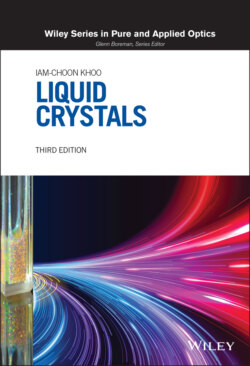Читать книгу Liquid Crystals - Iam-Choon Khoo - Страница 21
1.4.1. Mixtures
ОглавлениеA large majority of liquid crystals in ubiquitous devices are eutectic mixtures of two or more mesogenic substances. A good example is E7 (from EM Chemicals), which is a mixture of four liquid crystals (cf. Figure 1.15). The optical properties, dielectric anisotropies, viscosities of E7 are very different from those of the individual mixture constituents.
Figure 1.15. Molecular structures of the four constituents making up the liquid crystal E7 (from EM Chemicals).
Creating mixtures is an art, guided, of course, by some scientific principles. One of the guiding principles for making the right mixture can be illustrated by the exemplary phase diagram of two materials with different melting (i.e. crystal → nematic) and clearing (i.e. nematic → isotropic) points, as shown in Figure 1.16. Both substances have small nematic ranges (Ti–Tn and ). When mixed at the right concentration [2], however, the nematic range () of the mixture can be orders of magnitude larger. To date, there is an assortment of nematic liquid crystals, for example, with an operating temperature range from sub freezing (<−30 °C) to well over 100 °C that found their way in ubiquitous display devices (Figure 1.16).
Figure 1.16. Phase diagram of the mixture of two liquid crystals.
If the mixture components do not react chemically with one another, their bulk physical properties, such as dielectric constant, viscosity, and anisotropy, are some weighted sum of the individual responses. Since optical and other parameters (e.g. absorption lines or bands) are largely dependent on the electronic responses of individual molecules, they generally follow such a simple additive rule. Other physical parameters such as viscosities, transition temperature, and elastic constants are highly dependent on intermolecular forces and therefore follow more complex physio‐chemical rules (see e.g. [2, 13]).
